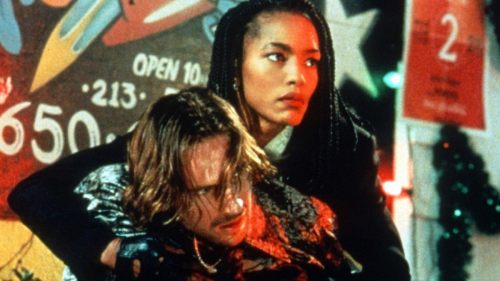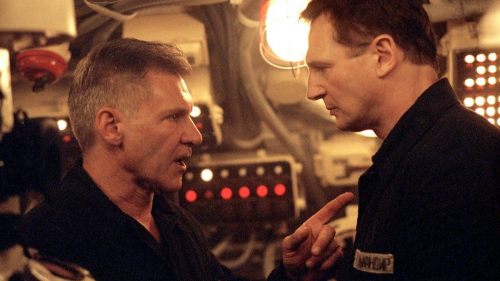The Deafening Night: Kathryn Bigelow’s NEAR DARK
“How old are you, Jess?”
“Let’s put it this way: I fought for the South…we lost.”
Near Dark is a vampire film. Except it’s not. Near Dark is a Western. Except when it doesn’t want to be. This is what makes Kathryn Bigelow’s solo feature directorial debut so endlessly fascinating: the picture’s utter refusal to abide by any set of concrete rules. Sure, there are elements of both the bloodsucker and Old West genres tossed in, yet just when you get comfortable with one of the movie’s magic tricks, it pulls the rug out from under you. In the end, all that remains is a sole unifying aspect: the primal, grimy sensuality that pervades every single frame. Near Dark is a movie that’s downright romantic, except for when it decides to slit your throat and drain your throbbing jugular into a beer mug.
Young lust is what sets us down a road to potential damnation, as cocky cowboy Caleb (Adrian Pasdar) can’t help but approach the pale pixie he sees hanging outside of his local Oklahoma watering hole. Mae (Jenny Wright) is “unlike any girl he’s ever met”, but what first starts as a simple pick-up line reveals itself to be undeniably accurate. The kid’s caught up in a whirlwind of hormones, yet Caleb can’t help but notice peculiarities about his latest infatuation. Why are the horses scared of her? How is this seemingly frail creature so strong? What does she mean when she implies she’s older than a star’s dying light? Though he may be thinking with his dick, the boy’s lizard brain can’t help but want to reconcile these idiosyncrasies. “Listen to the night,” she tells him, “it’s deafening.” Before Caleb knows it, Mae’s biting him on the neck during an intense make out session, quickly exiting his beater pick up before scurrying off into the night.
What subsequently transpires isn’t so much an abduction as it is a reluctant assimilation. Swooping in like a wagon load of banditos, Mae’s twilight “family” scoops Caleb up into a battered RV as he staggers home – pale, sick and starting to somehow smoke beneath his jacket. It’s in this moment that Bigelow melds a horror sensibility with Texas gunslinger iconography. Barely able to pick his feet up as the sun rises over the horizon behind him, the dust and smoke swirl and mingle, until one cloud is indecipherable from the other. Once inside the blacked out vehicle, we’re just as confused as Caleb. A dirt smeared miscreant holds his spurred boots above our face, threatening to take it “clean off”; four others debating up front what to do with him. Thankfully, Mae comes to the rescue, claiming Caleb as hers, much to the disdain of nearly everyone else inside of the recreational vehicle.
Through a mixture of deft casting and sparse, telling lines of dialogue (Eric Red’s early '80s genre writing still sings to this day), a portrait of these perceptibly bad, gun-toting misfits comes into full focus. Jesse (Lance Henriksen) is the leader – a brash combo of rasp and swagger who carries decades of experience under a tattered duster. Diamondback (Vasquez herself, Jenette Goldstein) is the lethal mother, looking over Homer (Joshua Miller), a “big man on the inside, trapped in a small body on the outside”. Most colorful of all is Severen (Bill Paxton), the roadhouse warrior who will do a dance on your face after drinking down your donkey piss beer. Each navigates the Texas landscape as if they own it, Terminator cinematographer Adam Greenberg making sure to shroud them in smoke and darkness. Their lethal nature is revealed as they try and teach Caleb to feed on the blood of the innocent, but it isn’t until they force their newest member to sadistically act inside of a “shit-kicker heaven” dive that their ferocity is unleashed to its max potential. This is a set of villains for the ages, and though they certainly keep odd hours, don’t you dare use the “V word”.
Not too long ago, there was an odd assertion made that Kathryn Bigelow was somehow a “craftsperson”, and wasn’t regarded by most as an auteur until after The Hurt Locker and Zero Dark Thirty. This is, quite frankly, incorrect. Bigelow has always been a tidy capturer of filmic action, keeping her frame constantly active and alive, while still recognizing the need to establish geography within each chaotic scene. While there isn’t a foot chase as electrifying as the multi-environment drug bust from Point Break, or a set piece as nail-bitingly tense as the POV drug trip opening in Strange Days, Bigelow proves with Near Dark that she’s always been the queen of muzzle flare greatness, staging a brief siege sequence that would make Howard Hawks grin with glee. Cornered in a rundown bungalow and surrounded by automatic weapon-toting Texas patrol, the clan has to shoot their way out as Caleb dives through a window and makes a mad dash for the van. It’s a bombastic, bullet riddled piece of action bravura, rivaled only by a fire and brimstone “High Noon at midnight” finale involving a tractor trailer and some scorching sunlight. Bigelow always had her own visual signature; some just needed the Academy to recognize her with bald gold dudes in order to jump on the bandwagon.
Despite all the blood, dirt, sweat, spit and piss that coats every character, Bigelow never loses sight of the youthful romanticism that defines the couple at the core of Near Dark. Though they may be a pair of ever-evolving ruthless bloodsuckers, Caleb and Mae also become avatars for reckless teenage abandon, running off into the darkness and exploring each other’s’ bodies inside of its blackness. They are haunted, but not by any vampiric curse. Like any kid who’s been enveloped up by the essence of another, they are haunted by each other’s soft forms; wanting to do nothing more than curl up together and stare at the stars. They are the King and Queen of the Night, inhabiting a lovelorn cavern that neither knew could be filled by another person. As horrific as Near Dark can be, it’s also crushingly beautiful, capturing the new sun that rises over all of us when we find completion in another.
As the final notes of Tangerine Dream’s hypnotic score rise over the end credits, Near Dark leaves you in the light. It’s a classic Western trope, re-contextualized for the vampire film. Where we’re used to seeing the lone gunslinger ride off into the sunset, the clop-clop-clop of a horse’s hooves carrying the cowboy off to another town that requires saving, Bigelow abandons us to bask in the sun’s warming rays, knowing that we’ve already been rescued from oblivion by ridding ourselves of violence. A return to civility, away from the savage murderers who call the night home, is the reward for those who can survive until morning. In a way, it’s the ultimate Mexican stand-off, in which everyone is hoping they can be purified (via the film’s wonkiest narrative turn – a full transfusion) so that they may live to experience another day with their blood relatives.



